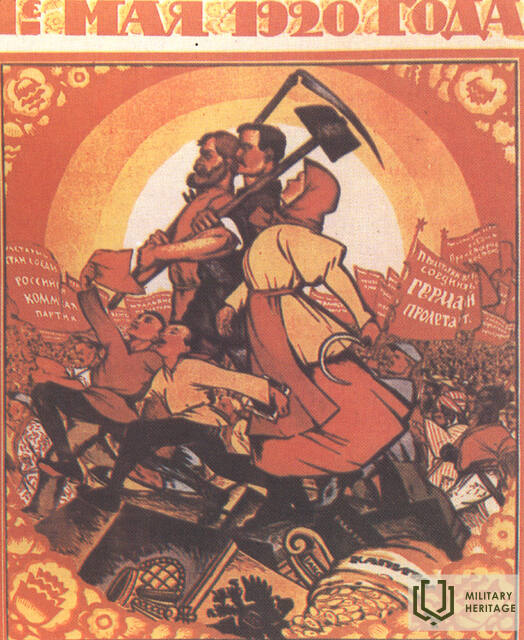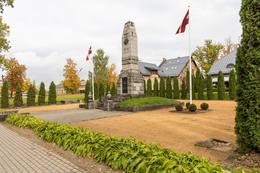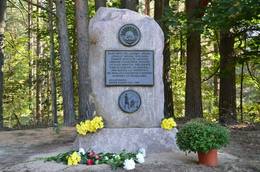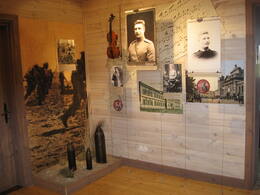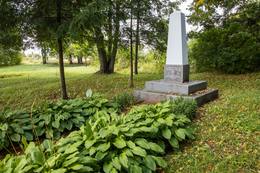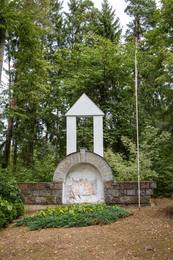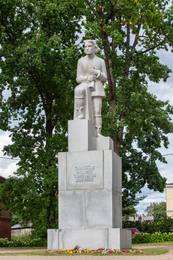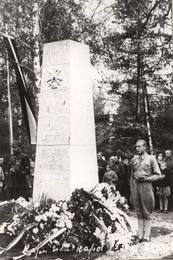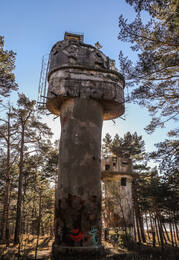Latvijos Sovietų Respublika, 1919–1920 m.
I Nepriklausomybės karai
Latvijos Socialistinė Tarybų Respublika – sovietinis režimas Latvijoje. Sovietų Latvija buvo iš dalies suvereni iki 1919 m. birželio 1 d., po to ji faktiškai tapo Sovietų Rusijos dalimi.
Susijusi laiko juosta
Susijusios vietos
Paminklas žuvusiems Gulbenės parapijos didvyriams už Latvijos laisvę
Įsikūręs istoriniame Gulbenės centre, priešais Gulbenės evangelikų liuteronų bažnyčią.
Paminklas 1905 m. neramumų aukoms, Gulbenės bendruomenės nariams, žuvusiems Pirmajame pasauliniame kare ir Latvijos nepriklausomybės kare, bei Malienos tribunolo aukoms atminti. Paminklą suprojektavo E. Ābeltīns, o 1929 m. jis buvo atidengtas priešais Gulbenės evangelikų liuteronų bažnyčią. Po Antrojo pasaulinio karo ant paminklo buvo pastatyta penkiakampė žvaigždė, o ant jo pagrindo – bronzoje nutapytas gipsinis sovietų kareivio atvaizdas, o už paminklo įrengtos žuvusių sovietų kareivių kapinės. Kai 1969 m. Spārytės parke buvo atidarytos naujos Antrajame pasauliniame kare žuvusių sovietų kareivių kapinės, žuvusiųjų palaikai buvo perkelti į jas, tačiau paminklo vieta sulyginta su žeme. 1989 m. rudenį buvo iškasti paminklo pamatai ir išnešta kapsulė su tekstu, kuri juose buvo įmūryta 1928 m. Paminklas buvo restauruotas 1992 m. (skulptorius O. Feldbergs).
Nuo 1918 m. gruodžio 24 d. iki 1919 m. gegužės 31 d., kai 1-asis (4-asis) Valmieros pėstininkų pulkas išvadavo Gulbenę iš bolševikų, bažnyčioje veikė Malienos (Vecgulbenės) revoliucinis karo tribunolas ir Darbininkų klubas. Jo veikla pasižymėjo griežtais sprendimais ir dideliu mirties bausmių skaičiumi, dažnai už smulkius nusikaltimus – buvo ištirtos 349 bylos, kuriose kaltinami 606 asmenys.
Matoma memorialinė skulptūra.
Latvijos Nepriklausomybės karo įvykių atminimo vieta Marupėje
Įsikūręs Marupės savivaldybėje, kelio tarp golfo klubo „Viesturi“ ir Božių rezervuaro pusėje.
Memorialas atidengtas 2013 m. Vietovės istorija susijusi su Latvijos armijos mūšiu prieš Bermonto kariuomenę 1919 m. Netoli Adienių namo kovos pozicijose buvo dislokuoti Latvijos armijos daliniai.
Nepriklausomybės karo metu dėl sunkios padėties Latvijos vyriausybė neturėjo galimybių aprūpinti kariuomenės tuo, ko jai reikėjo. Kareivių išvaizda ir ginkluotė skyrėsi. Dažniausiai aprūpinimas buvo grindžiamas karių gebėjimu apsirūpinti patiems. 1919 m. rugsėjo pabaigoje ir spalio pradžioje iš Didžiosios Britanijos atvyko Latvijos karinis užsakymas trūkumui pašalinti. Po mėnesio buvo gautas ir angliškos ginkluotės siuntinys. Gavus pirmuosius krovinius, buvo aišku, kad Didžioji Britanija atsikratė nereikalingų atsargų. Taip pat buvo gaunami nešvarūs, susidėvėję drabužiai ir batai, kurie dažnai būdavo per maži. Kai kareiviai avėdavo netinkamą batą, kildavo sveikatos problemų, kurios paveikė jų kovines galimybes. Drabužiai buvo taisomi ir siuvami. Pagrindinis vienijantis simbolis buvo 11 spindulių saulės ženklas ant kepurės ir raudonai baltas tvarstis aplink kairę ranką.
Šiandien čia galima aplankyti keletą memorialinių vietų. Jos yra vaizdingo, specialiai sukurto istorinio ir gamtos žygių maršruto dalis.
Gidas Miķelis Jakunovas, +371 28353679.
Oskaro Kalpako muziejus ir memorialinė vieta „Airītes“
Oskaro Kalpako muziejus ir memorialinė vieta „Airītes“ yra tarp Saldaus ir Skrundos, netoli greitkelio A9. Parodoje pateikiama išsami informacija apie pulkininką Oskarą Kalpaką ir jo batalioną, taip pat pristatoma Latvijos nacionalinės armijos ir memorialinės vietos „Airītes“ istorija. Parodoje pulkininką Oskarą Kalpaką pristatoma kaip asmenybę, kaip karį ir kaip kovotoją už Latvijos nepriklausomybę. Parodoje taip pat yra garso įrašų latvių, anglų ir vokiečių kalbomis. Juose pabrėžiama 1918/1919 m. istorinių įvykių svarba saugant Latvijos valstybingumą. Muziejaus pastatas yra restauruotas.
Įėjimas nemokamas; ekskursija su gidu – mokama. Komplekse yra poilsio zona, parkas, kliūčių ruožas, galima lankyti įvairius užsiėmimus, yra seminarų salė iki 30 žmonių.
Paminklas 1-ojo Liepojos pėstininkų pulko kariams 1919 m. mūšių vietoje
Įsikūręs Meža Strodi kaime, Murmastienės valsčiuje, Madonos rajone, 6 km nuo Varakļānų.
Laisvės kovos paminklas stovi 1-ojo Liepojos pėstininkų pulko mūšio vietoje, kur jie 1919 m. kovojo su „raudonąja“ armija. Netoli šios vietos mūšyje buvo sunkiai sužeistas vietos gyventojas Aleksandras Lakstīgala. Jis buvo rastas negyvas prie netoliese esančio namo. Todėl ir buvo pasirinkta tokia paminklo vieta.
1936 m. rugpjūčio 16 d. Laisvės kovų atminimui buvo atidengtas granitinis Pergalės paminklas (kaip jį vadino to meto spauda), ant kurio buvo iškalti žodžiai: „1-ojo Liepojos pėstininkų pulko mūšių, aukų ir pergalių vieta Latgaloje, 1919 m. rugpjūčio 26 d. savo krauju nupirkome kiekvieną gimtosios žemės kampelį – dabar jis mūsų.“ Jį pastatė Rėzeknės gvardijos pulko vadovybė, pašventino Rėzeknės gvardijos pulko vyresnysis kunigas Vincentas Tomašūnas kartu su vietos parapijos kunigu Kalinku. Atidarymo paradą vedė Žiemgalos divizijos vadas, Lačplėšio ordino kavalierius Žanis Bachas. 1950 m. jis buvo nugriautas ir sunaikintas. 1996 m. lapkričio 16 d., minint Latvijos Respublikos paskelbimo 78-ąsias metines, buvo iškilmingai atidengtas restauruotas paminklas.
Paminklas „Talavos trimitininkas“
Įsikūręs Rūjienos centro aikštėje.
Trijų metrų aukščio senovės Latvijos gvardijos kareivio atvaizdas, išdrožtas iš pilko suomiško granito, vadinamas „Tālavo trimitininku“, pastatytas ant trijų metrų aukščio granito pjedestalo, tačiau bendras paminklo aukštis siekia 7,5 metro. Pradiniuose eskizuose ir modeliuose K. Zemdega į kario rankas įdėjo kardą, kuris vėliau buvo pakeistas trimitu. Paminklas buvo atidengtas 1937 m. rugpjūčio 15 d.
Šis paminklas atspindi sunkią mūsų valstybės ir kariuomenės kūrimosi situaciją, taip pat šių įvykių vertinimą. Iškart po Latvijos valstybės paskelbimo prasidėjo Raudonosios armijos puolimas, o laikinoji Karlo Ulmanio vyriausybė rado prieglobstį Liepojoje. 1919 m. vasarį, padedant Estijos armijai, prasidėjo Latvijos išlaisvinimas iš šiaurės, o Rūjienos apylinkėse įvyko pirmosios Tērbate besiformuojančių Latvijos kariuomenės mobilizacijos, kurios, vadovaujamos pulkininko Jorgio Zemitano, tapo Šiaurės Latvijos brigada. Šiaurės Latvijos brigada kovojo ne tik su bolševikais, bet ir su landesveru bei Geležine divizija Cėsių mūšiuose. Rūjienos apylinkėse mobilizuoti Šiaurės Latvijos kariai kovojo ir vėlesniuose Nepriklausomybės karo mūšiuose. Po karo pagrindiniai pergalės laurai atiteko generolui Jāniui Balodžiui ir jo vadovaujamai Pietų Latvijos brigadai, tačiau Šiaurės Latvijos brigada dažnai buvo pamirštama. Rūjienoje planuojamas Šiaurės Latvijos brigados paminklas taip pat užtruko ilgai, o 1937 m. atidengtas paminklas oficialiai buvo reklamuojamas kaip Rūjienos krašto išlaisvinimo ir žuvusių karių atminimo paminklas, nepaminint, kad visi Šiaurės Latvijos brigados pulkai savo ištakas turėjo Rūjienoje.
Paminklas yra ne tik populiari turistų lankoma vieta Latvijos ir Estijos turistams, tam tikru mastu tapusi atspirties tašku norint aplankyti keletą kitų Nepriklausomybės karo memorialinių vietų Rūjienoje, bet „Tālavas tauretājs“ yra ir sustojimo vieta įvairaus lygio Estijos ir Latvijos valstybės bei vietos valdžios pareigūnams.
Rūjienos išlaisvinimo ir žuvusių karių paminklas, geriau žinomas kaip „Tolamas tauretājs“ (Tolimas ragas), 1998 m. spalio 29 d. buvo įtrauktas į valstybės saugomų kultūros paminklų sąrašą kaip nacionalinės svarbos meno paminklas (paminklo apsaugos registracijos numeris 4522).
Karosta, Liepojos karinis uostas (ekskursija)
Karosta yra didžiausia istorinė karinė teritorija Baltijos šalyse ir užima beveik trečdalį visos Liepojos teritorijos. Karosta – unikalus karinių ir įtvirtinimų pastatų kompleksas Baltijos jūros pakrantėje, turintis ypatingą reikšmę Latvijos ir pasaulio istorijoje bei architektūroje. Karostoje yra tokie karinio paveldo objektai kaip Šiaurinis molas ir fortai, Redanas, Karostos kalėjimas, Karostos vandens bokštas, Šv. Nikolajaus stačiatikių Jūros katedra, Oskaro Kalpako tiltas ir kiti.
Susijusi istorija
Cėsių mūšis Amatos upės pakrantėje
Prie tilto per Amatą vokiečių landesveras puola deryboms atvykusį estų šarvuotą traukinį. Estai pradeda kontruguoti, vokiečiai atremiami, ir šarvuotas traukinys grįžta į Cėsį.
Cėsių mūšio pradžia, eiga ir pabaiga
Pergalė Cėsių mūšyje turėjo tapti lūžio tašku Latvijos ir Estijos kovoje už savo šalies nepriklausomybę. Ši pergalė sustabdė Andrijevo Niedros vyriausybės ir vokiečių generolo Rüdigerio fon der Golco planus užkariauti Pabaltijį. Vietoj to, Liepojoje savo veiklą atnaujino Karlio Ulmanio vadovaujama Laikinoji Latvijos vyriausybė.
Pulkininko Kalpako paskutinis mūšis netoli Airytės
Pulkininkas Kalpakas buvo gerbiama figūra kariniuose sluoksniuose ir tikras patriotas. Būtent patriotizmo dvasia ir nelaimingas atsitiktinumas lėmė lemtingą jo ir vokiečių batalionų susidūrimą, kuris, deja, baigėsi pulkininko Kalpako mirtimi.
Estijos karinis jūrų laivynas padėjo Latvijos pajėgoms Nepriklausomybės karo metu.
Birželio 23 d. estai švenčia Pergalės dieną, taip pažymėdami bendrą Latvijos ir Estijos pergalę Cėsių mūšyje. Ir šioje pergalėje reikšmingą vaidmenį atliko Estijos karinis jūrų laivynas, kuris šiame Landesvero kare, kaip jį vadina estai, savo drąsiais veiksmais ir taikliais patrankų ugnimi prie Dauguvos žiočių kėlė grėsmę pagrindiniams vokiečių pajėgų tiekimo keliams per Dauguvą, esantiems visai netoli Rygos.
Apie pirmąjį Latvijos armijos vyriausiąjį vadą Dāvidą Sīmansoną
Knygos „Latvijos armijos vadai“ esė įtikina, kad istorijai didelę įtaką daro konkretūs asmenys. Nors svarbiausių istorinių įvykių epicentre jie buvo trumpą laiką, tikri Latvijos patriotai, turėdami didelę karinę patirtį, sugebėjo daug nuveikti formuojant ir stiprinant Latvijos kariuomenę bei istorinių įvykių lūžio taškuose.
Ši istorija yra apie pirmąjį Latvijos armijos vyriausiąjį vadą Dāvidą Sīmansoną (1859–1933).
Kyšulys ir laivas „Saratovas“
Galima manyti, kad Liepoja trumpą laiką buvo Latvijos sostinė, nes Laisvės kovų metu Laikinoji vyriausybė buvo dislokuota laive „Saratov“ būtent šiame mieste. „Saratov“ po Rygos išlaisvinimo Laikinąją vyriausybę nugabeno į ją, tačiau daugelis žmonių nežino, kad tokio svarbaus mums laivo istorija baigėsi jūroje, Akmenrage.




